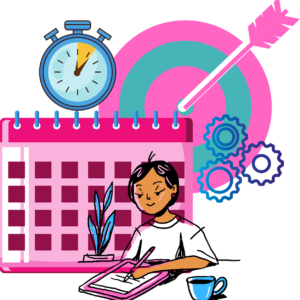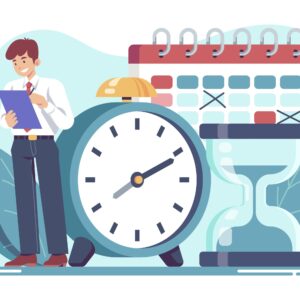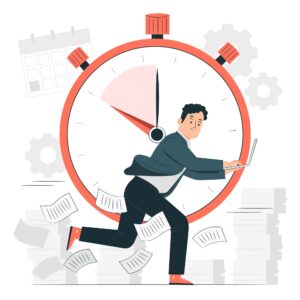
Tips to increase your productivity as a leader
Best Practices From Business Leaders – 19 Productivity Tips – Some people hold themselves accountable by logging work on productivity apps, while others turn to blogs and books inspirational productivity quotes. Regardless of how you motivate yourself to get things done in the workplace, now and then we all find ourselves searching for productivity tips to keep us moving forward. And if you don’t think this applies to you, consider this: research suggests that in an eight-hour workday, the average worker is only productive for two hours and 53 minutes. That leaves a lot of room for improvement.
There is a long time debate about whether success is due to luck or hard work, but regardless of your opinion, the most successful people have managed to optimize their talents, time, and overall productivity. Those who are able to find ways to overcome their productivity challenges and optimize their workload are the ones who ultimately go on to become industry leaders. These professionals have done just that, overcoming the struggles that many people face on a day-to-day basis in their careers. So to learn from the best, here are some great productivity tips to get things done faster.

1. Set goals on a daily basis
“Know what significant goals you want to work towards every day. I list a small number of high-value tasks or goals for the day.” – Rachel Haurwitz, CEO of Caribou Biosciences
Rachel Haurwitz, CEO of Caribou Biosciences says she sits down every morning with a blank sheet of paper and asks herself, “What can I do that benefits my business today? How will I improve my business today? today?
“Doing the same will help you identify the most important tasks you can accomplish throughout the day ahead, and saving your list allows you to track your progress as you check off the effects. How many days have ended with you looking back and saying, “Wow, I’m not really sure what I’ve accomplished right now.” Feeling like you’re unclear about what you’ve accomplished all day? Obviously, you are not alone, each person must spend time taking stock of the work accomplished, and reviewing their daily objectives to assess progress in their commitments.
Every day you spend working should always contribute to your success. Once in a while, using a list like this will help keep you on track and motivated, as you’ll be able to take the day one thing at a time, rather than being overwhelmed with a heap of unsorted ideas or running from one thing to another trying to figure out how to spend your time. And if you’re someone who likes to stay organized, you can also use an item-tracking app to produce lists and log accomplishments on the go.
2. Do the hardest thing first
Got your to-do list for the day, but the hardest question is where to start. When you come in the morning, you should tackle your least enjoyable task first.
Heading into the day, you generally have the highest energy and the fewest distractions, making it easier for you to focus on tricky tasks. It also sets a positive tone for the day after you dove into your hardest task first. One way to stick to this routine is to cut out all distractions. That means avoiding checking your notifications, phone, or social media until the toughest task of the day is done.
3. Review your week every Friday
“Review your diary at the end of each week. Literally, print it out and review it. It will transform how you spend your time.” – Scott Farquhar, Co-CEO at Atlassian
Some people go to bed at night with a whirlwind of thoughts racing through their minds. They hardly have time to reuse what they have just done with their day, simply because they are so stressed about what awaits them the next day. It is vital to set aside a block of time each week to sit down and review the previous week so that you can answer three essential questions
1. Did I achieve what I wanted to achieve?
2. Did I personally need to be there for everything I attended?
3. Could I have gotten the same thing in less time?
This is an important tactic to determine if you are really managing and spending your time wisely.
4. Identify your most productive time of day
Everyone has a particular time of day when they tend to have a burst of focus and creativity. For some people, that moment comes in the morning. For others, it may come after lunch or even during the evening. The most productive period is in the morning and lasts until early autumn. That means getting into the habit of cataloging all the meetings or video calls later in the day, so they don’t take away from your most productive time. You will also need to set priorities and schedules so that the tasks requiring the most attention and creativity are placed near the start of the day when you have the greatest capacity to work on them and complete them.
5. Start with just 5 minutes
“If you don’t want to do something, make a deal with yourself to do at least five minutes of it. After five minutes, you’ll end up doing the whole thing.” – Kevin Systrom, Co-Founder of Instagram
Procrastination is the enemy of productivity, but we’ve all been guilty of it at some point in time.
Systrom says that he beats procrastination by committing himself to do five minutes of whatever he is putting off. By the end of the five minutes, he ends up sitting doing, and finishing the entire thing.
This is a perfect example of the fact that starting is the hardest part, and taking action is the most important thing. Sometimes later is better, but most of the time, you’ll find that going ahead and getting little things out of the way will actually increase your productivity because you’re not allowing dishes to pile up in the sink. You’re instantly washing your hands off them.
6. Understand your priorities
“Saying ‘I don’t have time’ really means ‘it’s not a priority.” If someone offered you a ton of cash to do whatever you claim you don’t have time for…you’d probably find the time! So it’s not about time. It’s that it hasn’t risen up your priority list enough…and that is FINE. Plenty of things may sound good in theory but aren’t right for right now in practice. Embrace that reality and you can take back control of your time.” – Laura Vanderkam, Author and Productivity Professional
When we talked to Laura Vanderkam about how she maximized productivity, she shared the biggest takeaway from her book, 168 Hours: You Have More Time Than You Think. She says it’s not about how much time you actually have, Instead, it’s about how you choose to spend that time. This simple shift in mindset is empowering because it lets you take control of your day. Instead of feeling overwhelmed and time-strapped to do everything on your list, identify your top priorities and focus on those. The other things can wait.
7. Set Boundaries
Everyone knows the feeling of you making your to-do list, sitting down to tackle the day, and also finding yourself answering arbitrary questions and dispatches for hours on end. Suddenly it’s noon, and you’ve picked up and dropped so many different tasks that you don’t know where to focus next. Indeed, more frustratingly, you haven’t touched your own to-do list yet. To reduce these unnecessary interruptions and distractions, please set boundaries with your co-workers and associates early in the day.
1. Are there certain times you want to block off for your own tasks? 2. Is there a time window when people should come and ask you questions?
Setting those boundaries and communicating them effectively will help you manage leads, reclaim your schedule, and improve overall productivity.
8. Isolate yourself from distractions
Turn off everything—email, phone, stock tickers, news, etc.—as often as possible and focus on a single task without interruption.
Have you ever been focused on a project or activity and suddenly your phone starts vibrating non-stop? Do your contacts and friends send you notifications from Facebook, and start communicating with you by e-mail?
These distractions usually don’t hold your attention, but when they do in a moment of violent concentration, they can seriously disrupt it. For these reasons, it’s very important to mute everything whenever you need to spend several minutes (or several hours) working on an activity. It’s a tactic you could probably apply with extreme success, especially considering how many distractions we face on a daily basis. Your dispatch probably won’t get your immediate attention, and nothing more that wasn’t scheduled for the next 1-2 hours.
9. Don’t waste time on emails
Email is an effective workplace communication tool, but Sandberg’s email method suggests that long, detailed responses are often a waste of time. Sandberg responds to every single message she receives, but saves time by keeping them concise and to the point. Eliminating email fluff not only saves time but also ensures the recipient reads the entire email and recognizes the main takeaways. An email verification tool can also help in this process by separating genuine email addresses from fake ones.
Responding to emails quickly can also prevent the stress of a full inbox, which is overwhelming, unorganized, and difficult to sort through. In addition to quick responses, you can further improve productivity and save time with these email integrations. This is one of our top productivity tips.
10. Optimize your communication tools
What’s instead imperative is to move more of this work out of your inbox and into other systems that better support efficient execution.
You can’t, in other words, avoid this work, but you can find better alternatives to simply passing messages back and forth in an ad hoc manner throughout the day
So while we’re talking about emails, let’s talk about Cal Newport’s major focus: that emails are not the optimal method of communication in the modern workplace. An author who writes about the intersection of technology and culture, Cal Newport is outlining his thoughts about email in his new book, “A World Without Email.”
In this book and on his blog, Cal emphasizes that our current reliance on email is not efficient, and is not sustainable. He says instead of trying to manage an overwhelming number of emails and a crowded inbox, the solution is to instead consider a new set of tools for communication. We agree with Cal, which is why Hive Mail lets you create, assign, and delegate tasks right from your email. No more back and forth between all of those windows.
11. Get some sleep
When we take time to sleep, recharge we are more effective as entrepreneurs, as leaders,” Huffington says.
Our cognitive performance improves. We make better decisions. We are less reactive. We get less upset when bad things happen
Ariana Huffington believes that sleep is a crucial component of success, and this is one of our top productivity tips for physical health. In an interview with CNBC, Huffington says that “a good day starts the night before.” This view is contrary to a lot of the traditional stereotypes associated with high-performing business leaders, who are willing to work long hours and sacrifice sleep to get things done. However, Ariana suggests that overworking can actually hinder performance and lead to burnout.
The next time you are tempted to stay up late and work with a frazzled brain, get some sleep and revisit the task in the morning instead. Taking the time to sleep may actually help your brain recharge, boost cognitive performance, and ultimately improve your effectiveness at work.
12. Plan for tomorrow
In an interview we did with productivity expert David Allen, he told us that he always takes time at night to plan for the next day. He separates his obligations into two buckets, which he calls his hard landscape and his “soft landscape. The hard landscape refers to external commitments that he cannot shift around. These would be things like meetings or interviews with people outside of his team. He uses these obligations to create a framework for his day.
From there, he notes other things he has to do for the day, but those “soft landscape” to-dos can be moved around and fit in wherever needed. Planning the night before can help you start the day with your priorities and expectations in check.
13. Create a routine
When Jack Dorsey is asked about how his top productivity tips to stay on-task as CEO of both Square and Twitter — which now has more than 353.1 million users and 206 million daily active users worldwide — he notes that he has a very specific routine that keeps him on track. Each day of the week has a different theme, and he assigns the correlating tasks to a time slot within those days. This really lets him dig into the theme and concepts at hand without getting distracted by everything else that isn’t directly related.
And Jack is not the only businessman who talked about this. CEO of consulting company Emirabiz, Andrew O. also shared with us the perks of being focused each day on different parts of your business. That way he has enough time for all of his projects and doesn’t waste time on topics that are not important. For him, it is extremely important to stay well organized since he is working with people from different time zones.
14. Automate manual tasks
No matter your role, you’ll find yourself doing repetitive, low-value work. Automating your manual tasks is one of the best ways to increase your productivity, outsize your impact, and stay focused on high-value work.
When we talked to Wade Foster about how he stays productive during a typical day, we weren’t surprised to hear that automation plays a big role in his work habits. After all, that is the main goal of Zapier, a tool that helps connect platforms and automate tasks throughout your workflow. But Wade makes a great point. If you find yourself repeating the same manual task over and over again, automation tools are a sure way to save time and take things off your plate, so you can spend time focusing on other more valuable tasks.
One important step to make this process effective is to identify tasks that can be automated. If you use Hive, there are several ways to automate tasks and actions within the app itself. To start using Hive Automate, simply visit the Apps section in your left-hand Navigation panel and select “Hive Automate.”
15. Time-block your calendar
Time-blocking helps you structure your day to condense work into a specific time frame and window, rather than staring at a long list of tasks on a to-do list.
Time-blocking is when you add specific time chunks to your calendar to help you focus on specific tasks, projects, or the vision of your business. This calendar trick is one of the best ways to boost your productivity while also providing structure to your workday.
CEO of Digital Marketing Company PageTraffic, Navneet Kaushal also shared an example of how he utilizes time-blocking for emails. Kaushal suggests blocking off 30 minutes every day at 10:00 am (or whatever consistent morning time works for you) and sticking to that schedule as best as you can. This creates a pattern and will help you start your day off on the right foot without lingering emails in your mind.
16. Take your breaks
There is a reason why powerlifters take five to six minutes to rest between sets, the energetic system takes that long to replenish properly.
Ferriss in his book 4-hour Body talks about a productivity misconception: “just because you’re not moving your body doesn’t mean that you aren’t working.” The author explains that mental work is in fact physical work, after all, your brain is physically burning neurotransmitters as you make thousands of small decisions each day. If the brain gets tired, bad decisions might be made.
You might try to squeeze in one more task here and there before allowing yourself to take a break, but the truth is that this won’t make you more productive. Studies discovered that regular movement breaks, such as short walks have an important impact on workers’ physical energy levels and comfort, without reducing productivity. You can schedule your breaks using Hive recurring tasks (or actions). Get creative with how you would spend your break: give a friend a call, sing out loud, make a fresh juice, or listen to your favorite podcast platform.
17. Avoid Multitasking
People think focus means saying yes to the thing you’ve got to focus on.
Tackling several tasks at the same time might be tempting or sound productive, but let’s be honest: it’s better to do one thing at a time to guarantee the quality of the things we do. According to MIT neuroscientist Earl Miller, when we think we are “multitasking”, meaning doing several things at once, we are in fact switching from one task to another very rapidly at a cognitive cost. In other words: multitasking is killing your brain! Hive has several features that can help you to focus, from to-do lists to defining priority levels for your tasks and even adjusting your notifications preferences. Try what works best for you and remember “A Journey of a Thousand Miles Begins with a Single Step”.
18. Drink Water
Water is life! We all know that, but you might be surprised to learn that even 2% of dehydration levels in the body can result in significant deterioration in mental functions. A study revealed that dehydration could cause variation in cognitive performance, impacting individuals’ short-term memory and arithmetic ability. So next time you feel thirsty, make sure to give your body all the fuel it needs to be productive.
19. Practice Mindfulness
As a true advocate of mindfulness, Marc Benioff encourages his employees to engage in meditation practice throughout the workday. He went as far as establishing ‘mindfulness zones’ in the workplace, dedicated spaces for staff to channel their inner zen.
Sometimes all you need is some separation from your smartphone and you’d be surprised how your cognitive abilities improve.
We’ve all likely found ourselves at a point of reaching burnout. That is why we need to hit our reset buttons regularly. The goal of mindfulness is to allow yourself to remain present with the understanding of what the moment truly is, just a tiny fraction of time.











1 Comment
Comments are closed.